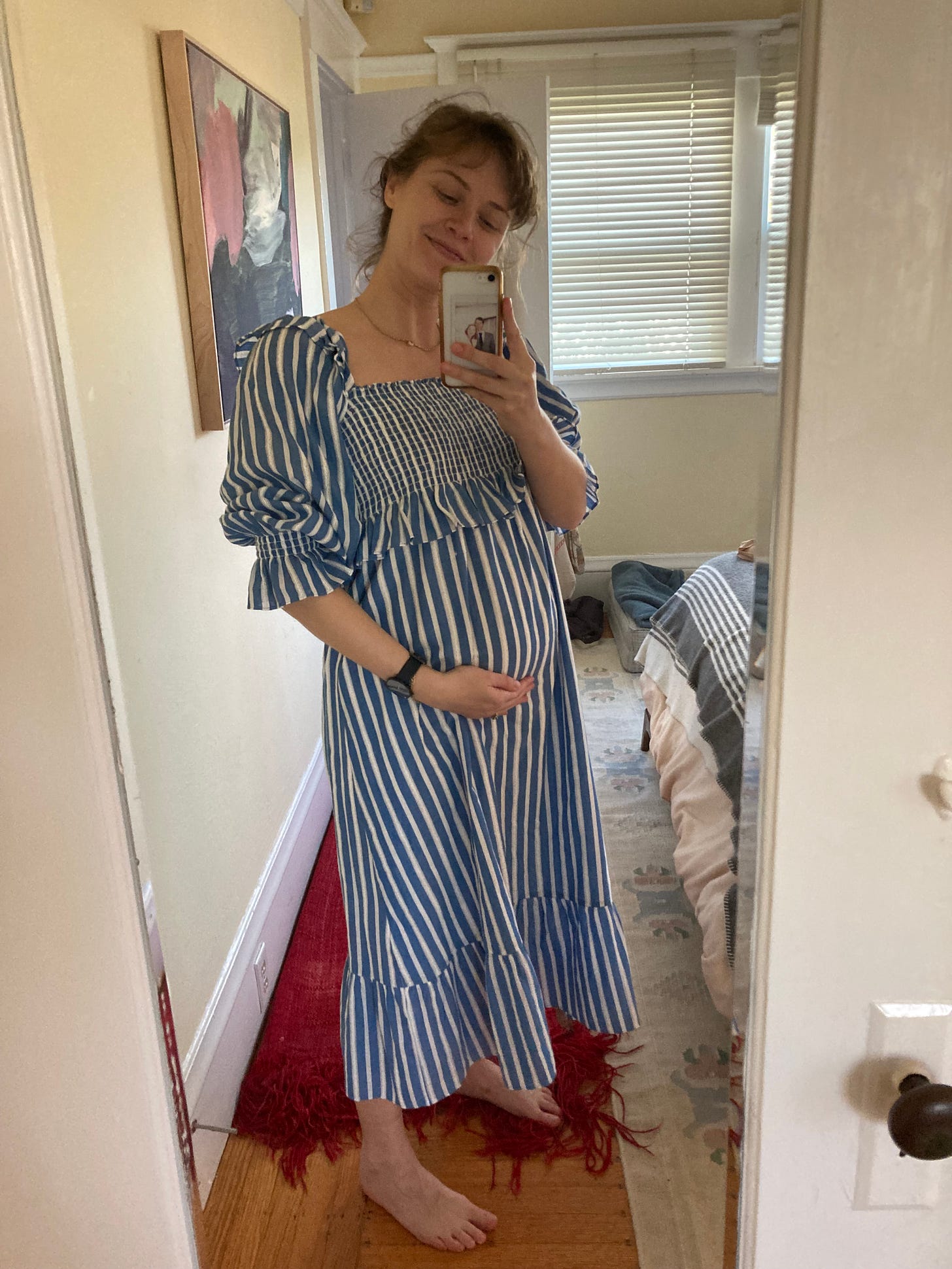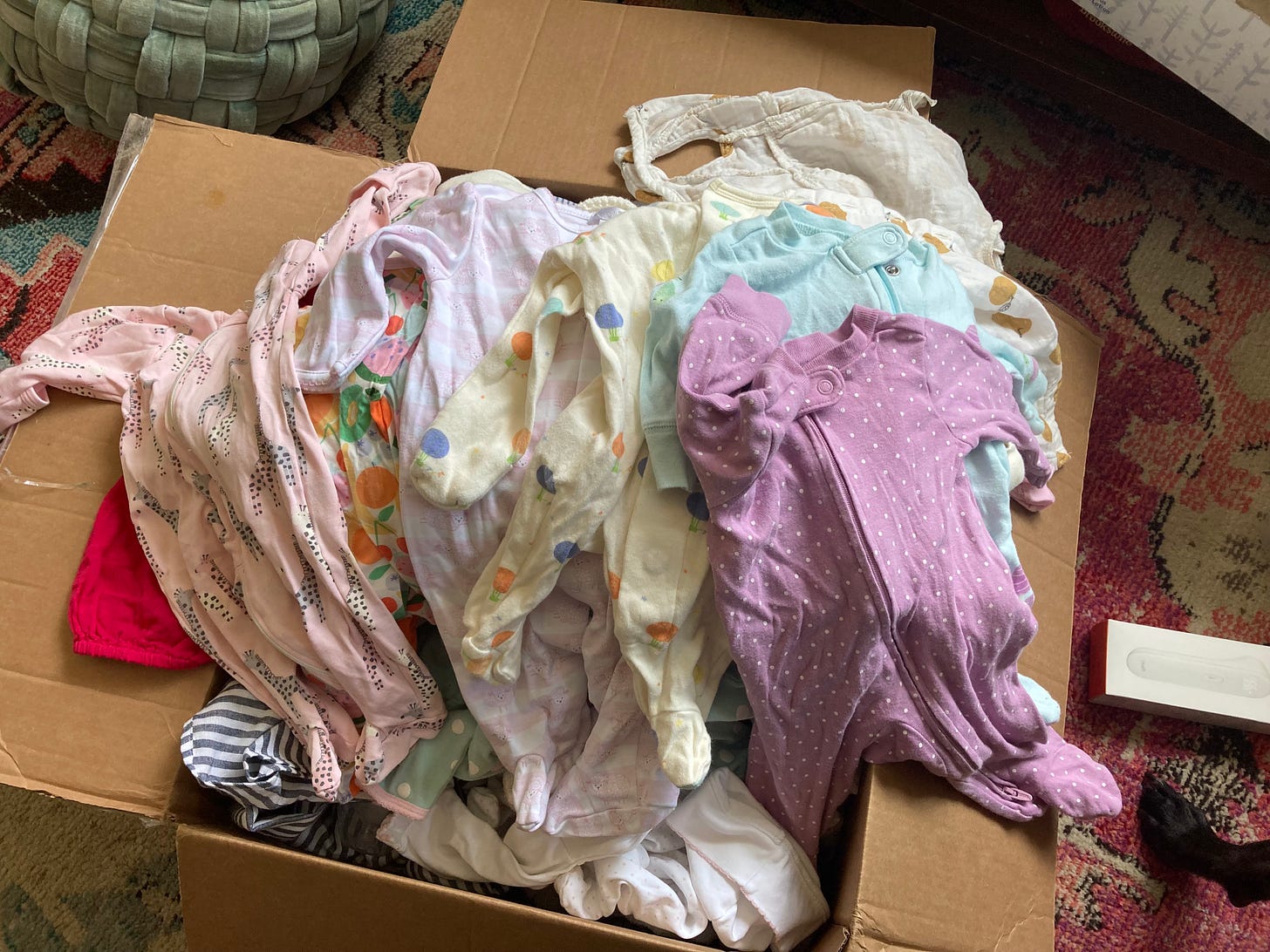A Self-Guided Pregnancy Syllabus
How to care for yourself while a fetus sucks the life out of you
In the last few years, first-time mom-to-be friends have started to come to me with questions. They know that I love talking and writing about pregnancy as much as I hated being pregnant (i.e., a LOT). The process of creating new life generates a new intimacy between us, one that is not shy to mention blood and the color of our nipples and exactly what is uncomfortable about sex during pregnancy.
Though I’m sure my friends are soliciting advice from lots of other people, there’s one question they come to me with. “What should I read??”
This list started taking shape, though it previously existed only in the form of dashed off text messages. I thought I would compile and share a pregnancy syllabus here. But I realized that, as voraciously as I read during pregnancy, there was so much else that went into my preparation for childbirth and parenthood— podcasts and classes and therapy and conversations. The syllabus expanded. I’ve had to break it into multiple posts. There are things to read but also things to do. It’s geared toward first-time parents, but even parents expecting second or third kids might find some interesting things to click on.
And an obvious disclaimer—I’m no expert. I have only been pregnant once, and spent most of my pregnancy sitting on the toilet puking into a doggy poop bag while peeing. I didn’t exercise a single time during my pregnancy. I ate turkey sandwiches nearly every day of my third trimester (which you’re not supposed to do!!) because they were the only thing that quelled my nausea. I don’t endorse any of the above. But I do endorse the below. Please heartily ignore anything that doesn’t speak to you. Part of this journey is learning what does, and does not, feel important to you.
So you want to have a baby! (The "Trying” Phase)
Take prenatals. Go out dancing. Sneeze without peeing your pants. Enjoy every day in which you are the only one inhabiting your un-pregnant twenty or thirty-something body. Even if this is bittersweet and if you desperately want to be pregnant, continue to love and cherish your body. It is your home and it has gotten you this far.
Conquer any preexisting fear of needles. There will be a lot of needles during pregnancy.
Surrender. Any plans you have for the next year may be cancelled. Any hopes of pregnancy in the next year may be dashed.
Americans living in dystopia: figure out how your insurance benefits. Expect to meet your deductible the year you give birth. Check your insurance plan’s annual out-of-pocket max—a number higher than your deductible. (The way my plan worked, for example, was that after meeting my $1500 deductible, I was responsible for 40% of my hospital bills until I hit my $16,000 out-of-pocket max. My insurance plan wouldn’t cover 100% until I spent $16,000 out-of-pocket.) Compare your plan’s benefits with your partner's and figure out when open enrollment is if it makes sense to switch. The out-of-pocket max per individual on my husband’s plan was only $4000, so by switching, we were able to avoid potentially spending an additional $12,000 out of pocket.
Americans living in dystopia: know if you live in a state that has bans on abortion care. It may impact your ability to get emergency lifesaving care during pregnancy and childbirth, or your ability to make some really difficult decisions if the pregnancy is not healthy. It is a shitty reality that, in many states right now, it is illegal for doctors to provide what would be considered the medical standard of care in many scenarios. Most of us can’t just uproot our lives in order to be pregnant elsewhere, but this is something to be aware of before you notice spotting in your underwear during the first trimester.
Figure out what your parental leave situation is. Figure out what your partner’s parental leave situation is. (This especially applies to Americans living in dystopia.)
So you’re pregnant! (The first trimester)
Find a way to soothe your nerves. The miscarriage probability calculator gave me a lot of comfort (but might make some people feel very anxious). Know what kind of person you are.
Ease into pregnancy research with something gentle. Pick up a copy of Nurture by Erica Chidi Cohen
Don’t underplay your suffering. Do whatever you can to bypass the advice nurse line to speak to a doctor (“I’d like to speak to the OB on call, please.”) Do not let a nurse convince you that your unrelenting nausea and vomiting will be alleviated by GINGER CHEWS and by keeping SALTINE CRACKERS and TUNA FISH on your nightstand. Demand better drugs for your nausea. It’s called zofran.
Eat protein. It’s counterintuitive when all you think you can stomach are bland carbs, but protein is better than carbs for absorbing nausea. Find a form of protein you can stomach (crispy chicken sandwiches, breakfast sandwiches, or my first trimester stalwart, chicken tikka masala at 11 am) and go with it.
Decide who you want to care for you. Consider what kind of prenatal care you want and where you want to give birth. If you love your OB/GYN, ask them how they handle deliveries in their practice. Is there a chance your baby will be delivered by whoever is on-call in the practice that day? Does this mean the baby could end up being delivered by a male doctor or by an OB/midwife you’ve never met before? Does this matter to you?
My very quick soapbox: Certified nurse midwives (CNMs) are nurses with advanced degrees in midwifery and they deliver babies in all types of settings, including hospitals. They are integrated into many OB practices, and also exist in private practice. If you are the type of person who craves more individualized attention/longer visits where all of your questions are answered, are concerned about unnecessary interventions during childbirth, and want to know the person who is going to deliver your baby, you may want to consider looking into the midwife path.
You may also have the option of receiving group prenatal care, through a program like the Centering Pregnancy model. I’ve had friends really appreciate this model of prenatal care, which places you in a cohort and gives you more time with a doctor or midwife.
Another thing to consider is where you want to give birth. Even if you know you want to give birth in a hospital and not a bathtub or birthing center, you might consider whether the hospital where your preferred care provider delivers is a good fit for you. Check out their c-section and episiotomy rates1, and how they compare to the state or national average. Check to see if the hospital is a baby-friendly hospital, which means the hospital has adopted a number of policies and practices to promote breastfeeding. It’s okay if you don’t know yet if you want to breastfeeding. But if you know that you do or you know that you don’t, this is something to consider. DM me if you want to know more about what this “baby-friendly” designation means in practice.
Take care of your mental health. If you’ve been thinking you might want to find a therapist, now is a great time, so you are not scrambling to find someone postpartum. If you are on an SSRI or any other kind of medication for depression or anxiety, talk to whoever currently manages your medication and if you’re not satisfied, consider finding someone who specializes in perinatal mental health. There are medications for depression and anxiety that are safe to take during pregnancy and breastfeeding and experts who can help you navigate those decisions.
So you’re starting to look a little pregnant instead of just bloated! (The second trimester)
You’re almost halfway there. Hopefully you feel better than you did in the first trimester. I did not, but most people do.
Don’t spiral alone. Any weird symptom is probably a totally normal pregnancy symptom, but it doesn’t hurt to ask your doctor.
Treat yourself to a nice pair of maternity leggings. Disregard Alison Roman’s statement that you don’t need maternity clothes. Find a couple of things you feel good in that you can dress up and dress down - a black bumpsuit, coveralls, leggings, one nice dress from Hatch. H&M and Old Navy make good maternity basics when it’s suddenly 80 degrees and you realize you need shorts.
Go to couples counseling. The next year is going to be hard! Get ahead of it. Talk about your hopes and your fears and how you are carrying the mental load and what kinds of parents you want to be and what kind of boundaries you want to set with your families.
At the very least, take this “baby-proofing your marriage” class.2
Consider a doula, or who in your life might play a doula role. You’ve probably heard people talking about doulas. What are they? Do you want one? Now is the time to look into it and hire someone. As defined by the Sokana Collective, a doula is a “is a trained professional who provides non-medical support throughout pregnancy, birth, and postpartum, keeping in mind the delicate nature of providing this support to marginalized communities. This support includes education, self-advocacy, coaching, and nurturing.”
A birth doula is a doula who specifically provides support during labor and delivery. She is there as your advocate, to help ensure your birth preferences are respected, and to support you and your partner during childbirth. Doulas can be especially valuable in situations where you anticipate having more difficulty advocating for yourself and being heard (if you are a woman of color, if you want to minimize interventions in a setting where that is not a cultural norm, if you know you are unlikely to know the doctor delivering your baby), but one of the benefits of a doula is having someone in the room with you who has seen it all before. They can also help you prepare for birth. With ours, we had a few prenatal sessions to prepare us for birth, in which we discussed everything from things I could do in the final weeks to get baby head down, to massage techniques my husband could use during labor.
One thing I didn’t know until I was pregnant was that you might not see your OB very much during labor. They’ll be delivering other babies on the floor. An L&D nurse will be in and out while you are laboring, but will spend most of her time at the nursing station monitoring the contractions of everyone on the floor. In contrast, your doula is with you the whole time, providing everything from practical support (staying in the room with you while your partner goes to eat, caucusing with your partner and the healthcare professional over interventions), emotional support, to physical support (massaging you), depending on what you have discussed together and are comfortable with. I was really anxious about not knowing when we should go to the hospital, and was comforted that our doula would come to our house to help me labor comfortably at home for as long as possible and then know when it was time to go to the hospital. (Though this ended up being irrelevant, since I was induced.)
A postpartum doula is someone who comes to your house to help care for you and your newborn. You may have her do overnight shifts (she’ll hold the baby for hours so you can get some sleep) or have her come for a few hours during the day so you can take a shower. Some will cook for you. Many will fold laundry, wash pump parts, assist with breastfeeding, and be someone to talk to at 2 in the morning when the baby is screaming and will not latch.3 Even if you plan to breastfeed, a postpartum doula is very much worth it! My advice to everyone is to line up as much overnight help as you can afford. But it is expensive. Really expensive. We asked our parents for help. We put the money we saved on baby gear by shopping secondhand (see below) toward a doula. If a postpartum doula is out of reach, do you have willing retired grandparents or friends who will help out a couple of nights a week? Even one or two nights of help in the first two weeks will help you and your partner recharge and stabilize.
Create a registry. I was initially resistant to creating a registry, until I realized that people were going to send me gifts no matter what and that our child would suffocate in stuffed animals and baby blankets! I chose to use Poppylist instead of the more-ubiquitous Babylist, since it allowed me to stagger delivery of items (I didn’t need a pack n play or crib being delivered to our tiny house when I was six months pregnant) and (sshh) exchange gifts for cash.
Shop secondhand. If you have the energy, use Facebook Marketplace or the equivalent to find barely used stuff secondhand for a fraction of the price. Things I found on Facebook Marketplace included an unused Babyzen Yoyo stroller, the accompanying Babyzen Yoyo bassinet attachment, a Baby Bjorn carrier, a good-as-new Ergobaby Omni 360 carrier, a Baby Bjorn bouncy chair, a Keekaroo diaper changing pad, a Dockatot, and a Thule jogging stroller—a few thousand dollars worth of gear for a couple of hundred. We got our carseat and crib mattress new, via our registry. From friends, we got a lot of hand-me-downs—clothes, all of the various kinds of swaddles, the Stokkee Tripp Trapp infant seat, a bassinet, a bottle warmer, etc.
Good Buy Gear also offers gently used and open box items for a fraction of the cost.
You can ask for a gift certificate on your registry. We got our Slumberpod on Good Buy Gear, which is hands down my most recommended piece of baby gear if you think you’ll be traveling with your kid in the first two years.
Some reading to get you started:
Matrescence by Lucy Jones. You’ll probably want to reread this after the baby because so much of it will be felt deeply in your bones, your boobs, and your womb, but no book better captures the HUGENESS of the transition that you are undergoing. If you read nothing else on this list, read this!
Birth Control: The Insidious Power of Men Over Childbirth by Allison Yarrow.
Invisible Labor: The Untold Story of the Cesarean Section by Rachel Somerstein. Paired with Birth Control, above, Yarrow and Somerstein will teach you more about childbirth in the United States than you will learn in any class. They both weave their own birth stories through fascinating cultural, medical, and political histories of obstetrics and childbirth. Don’t be scared—you’ll come away inspired to assert yourself.
For something where the focus on pregnancy is a little more oblique, try Joanna Novak’s Contradiction Days: An Artist on the Verge of Motherhood. For something lighter and funnier (but deeply moving), try Catherine Newman’s Waiting for Birdy: A Year of Frantic Tedium, Improbable Grace, and the Wild Magic of Growing a Family. It’s about being pregnant with baby #2 while parenting a toddler, but will delight even first time-parents.
Stay tuned for the third and fourth trimester syllabus, coming soon!
Leapfrog is a great resource if you want to check out hospitals that rely on CNMs and that meet c-section and episiotomy standards.
Disclaimer! Aaron Steinberg is a friend but we also took this class and found it soooo helpful.
You may have also heard people recommended hiring a “night nurse” or a “baby nurse.” My understanding is that they offer baby care similar to what a postpartum doula provides, but are specialists in baby care—not postpartum care. They’ll hold the baby, but probably won’t cook, or sit on the edge of your bed and listen to your birth story while you weep. Either way, what’s most important is finding an unobtrusive person who brings the right energy into your nest.







I love this so much! So much valuable advice here. I find it hard to tell pregnant/postpartum friends what they should expect in a way that’s informative and honest but not scary, and this does that perfectly. I will definitely be sharing! Thank you for writing it!
Also, we bought almost all of our gear used as well - and most of exact same products and brands as you, haha. We also saved soooo much money, plus avoided the hassle of putting everything together. It’s also a way to feel like you’re being eco-friendly, since a lot about having a baby often feels like the opposite. 😅
I lived this with you, but reading about all the intricacies and background material was inspiring. This will serve as such a guide for mothers and fathers-to-be. I wish I had had this information when pregnant with you!